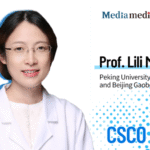
Editor’s Note:The 54th Annual Scientific Meeting of the International Society for Experimental Hematology (ISEH 2025) was held from September 24–27 in Kumamoto, Japan. This prestigious event brought together leading experts from around the world to discuss cutting-edge developments in basic hematology, immunology, stem cell research, and cell and gene therapy. One of the highlights of this year’s meeting was the “Sino-Japanese Joint Symposium on Stem Cells and Cellular Therapy,” co-organized by the Institute of Hematology & Blood Diseases Hospital, Chinese Academy of Medical Sciences (CAMS), and Kumamoto University, marking the successful restart of the Sino-Japanese academic exchange mechanism. During the conference, Oncology Frontier – Hematology Frontier invited Professor Tao Cheng of the Institute of Hematology & Blood Diseases Hospital to share his insights on the origins of this joint symposium, the hottest frontiers in the field, and opportunities for young researchers to engage internationally. On the Origins and Significance of the Sino-Japanese Joint Symposium
Oncology Frontier – Hematology Frontier:ISEH 2025 featured a special “Sino-Japanese Joint Symposium on Stem Cells and Cellular Therapy.” As one of the organizers, could you share the motivation, background, and academic significance of this initiative?P
rof. Tao Cheng:Holding the ISEH Annual Scientific Meeting in Japan is highly significant. Japan’s geographic proximity provides a great opportunity for Chinese scholars to actively participate. This year, the conference attracted over 400 registrants, including more than 70 participants from China — the highest number in the event’s history. To align with the theme of the conference, a dedicated Sino-Japanese symposium was organized ahead of the main sessions, focusing on cutting-edge topics in stem cells, cellular, and gene therapies, thereby deepening academic exchange between the two countries.China and Japan are both at the forefront of biomedical research. In fact, during my student and residency years, there used to be a Sino-Japanese Hematology Forum, which successfully held three editions before being interrupted for various reasons. This year, we successfully revived this exchange mechanism, which yielded excellent results. Leading experts from both countries delivered outstanding academic presentations on topics such as CAR-T cell therapy, gene therapy, stem cell biology, and basic hematology research, earning wide recognition and enthusiastic responses from attendees.Experts unanimously expressed their hope to hold the second Sino-Japanese Frontier Forum on Hematology in China next year. This initiative carries long-term significance, as it not only builds a bridge for researchers and clinicians — particularly those engaged in cutting-edge technologies, interdisciplinary research, and translational medicine — but also promotes the sustained and healthy development of hematology research in both countries.
Key Breakthroughs and Future Trends in Cell and Gene Therapy
Oncology Frontier – Hematology Frontier:Research on stem cell and cellular therapy has advanced rapidly in recent years, with numerous breakthroughs and emerging technologies. What do you see as the most promising or disruptive areas of research, and what are the key trends for the coming years?
Prof. Tao Cheng:Cell and gene therapy have attracted tremendous attention in recent years, especially in translational medicine and clinical research, leading to several landmark achievements. Hematology has always been a pioneer in this field — the earliest successful cases of stem cell therapy, gene therapy, and immunotherapy all originated from hematologic research.China has rapidly risen to the forefront globally, now standing alongside the United States in the development of immune cell products, particularly CAR-T cell therapies. Gene therapy is also entering a new phase of opportunity. In the coming years, traditional cell therapy products — such as hematopoietic stem/progenitor cells and other tissue cell products — are expected to achieve further breakthroughs in China, especially in clinical applications.As a national platform for hematology research and clinical care, the Institute of Hematology & Blood Diseases Hospital (CAMS) has taken the lead in developing CAR-T therapies for leukemia and gene therapy for hemophilia, advancing these products into clinical use. Going forward, we will continue to play a leading role, accelerating the clinical translation of additional cell and gene therapy products and contributing to the sustained growth of this field.
Empowering Young Researchers and Clinicians
Oncology Frontier – Hematology Frontier:What would you like young researchers and clinicians engaged in stem cell and cellular therapy to gain from participating in this symposium, particularly in terms of integrating into the global research community?
Prof. Tao Cheng:The true value of the ISEH Annual Scientific Meeting lies not in its scale but in its academic quality. I hope that Chinese hematology professionals — especially those focused on basic research, translational studies, and clinical innovation — will actively participate in such international academic events. Through these platforms, they can enhance their clinical and research capabilities while advancing the progress of cell and gene therapy, particularly its application in hematologic diseases, thereby positioning China as a global leader in this field.I firmly believe that with the active involvement of young physicians, researchers, and graduate students, China will continue to lead internationally in hematology and in cell and gene therapy development.
Expert Profile

Professor Tao Cheng- Director, Institute of Hematology & Blood Diseases Hospital, CAMS- Member, Academic Advisory Committee, CAMS- Executive Director, Tianjin Institute of Medical and Health Research, CAMS- Director, Institute of Basic Medical Sciences, CAMS- Director, National Key Laboratory for Blood and Health- Executive Deputy Director, Haihe Laboratory of Cell Ecosystem


